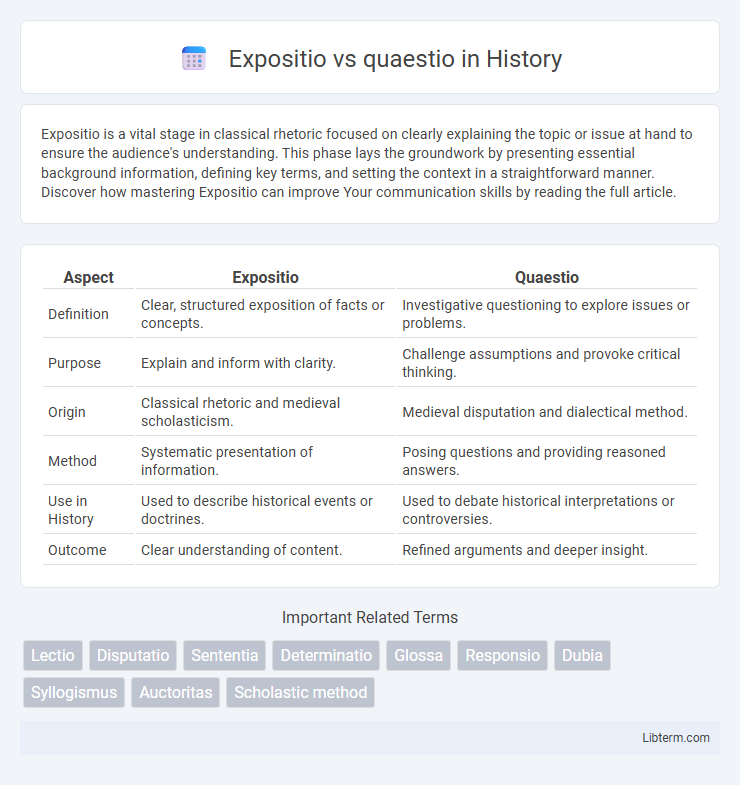Expositio is a vital stage in classical rhetoric focused on clearly explaining the topic or issue at hand to ensure the audience's understanding. This phase lays the groundwork by presenting essential background information, defining key terms, and setting the context in a straightforward manner. Discover how mastering Expositio can improve Your communication skills by reading the full article.
Table of Comparison
| Aspect | Expositio | Quaestio |
|---|---|---|
| Definition | Clear, structured exposition of facts or concepts. | Investigative questioning to explore issues or problems. |
| Purpose | Explain and inform with clarity. | Challenge assumptions and provoke critical thinking. |
| Origin | Classical rhetoric and medieval scholasticism. | Medieval disputation and dialectical method. |
| Method | Systematic presentation of information. | Posing questions and providing reasoned answers. |
| Use in History | Used to describe historical events or doctrines. | Used to debate historical interpretations or controversies. |
| Outcome | Clear understanding of content. | Refined arguments and deeper insight. |
Introduction to Expositio and Quaestio
Expositio and Quaestio represent two fundamental methods of scholarly inquiry in classical rhetoric and medieval scholasticism. Expositio involves the clear and systematic explanation of a text or concept, aiming to make complex ideas accessible and understandable through structured interpretation. Quaestio, by contrast, centers on formulating and exploring specific questions to challenge assumptions, stimulate debate, and deepen critical engagement with a subject.
Historical Origins and Philosophical Context
Expositio and quaestio originated in classical rhetorical traditions, where expositio referred to the clear, structured explanation of a topic, and quaestio involved posing and exploring a question or problem. In the philosophical context of ancient Greece and Rome, expositio served to present doctrines systematically, while quaestio functioned as a method of dialectical inquiry to uncover truth through debate and investigation. These forms shaped scholastic pedagogy, influencing medieval and Renaissance approaches to learning by balancing declarative knowledge with critical questioning.
Defining Expositio: Structure and Purpose
Expositio in classical rhetoric serves as the clear and detailed presentation of facts or arguments, designed to inform and set the stage for further discussion. Its structure typically involves a systematic explanation of terms, background information, and context to ensure comprehensive understanding. The primary purpose of Expositio is to provide a logical and coherent framework that supports the development of persuasive arguments in subsequent sections.
Understanding Quaestio: Methodology and Significance
Understanding quaestio involves examining a specific question or problem through systematic inquiry, central to medieval scholastic methodology. This approach emphasizes dialectical reasoning by presenting objections, articulating a clear thesis, and resolving contradictions through rigorous analysis. The significance of quaestio lies in its role as a foundational tool for intellectual debate, fostering critical thinking and clarifying complex theological or philosophical issues.
Key Differences between Expositio and Quaestio
Expositio presents information clearly and systematically, aiming to explain or describe a topic in detail, whereas quaestio centers on posing questions and exploring problems to encourage critical thinking. Expositio typically follows a linear structure with defined points, while quaestio involves inquiry and often multiple perspectives or arguments. The primary function of expositio is to inform, and quaestio seeks to provoke analysis or debate.
Usage in Medieval Scholasticism
Expositio and quaestio were fundamental methods in medieval scholasticism for structuring theological and philosophical discussions. Expositio involved detailed explanation and commentary on authoritative texts, serving to clarify and interpret established doctrines. Quaestio presented specific questions or problems for systematic debate, encouraging dialectical analysis and resolution through logical argumentation.
Analytical Techniques: Exposition vs Questioning
Expositio emphasizes clear, structured presentation of information, employing logical frameworks and evidence-based arguments to clarify concepts thoroughly. Quaestio prioritizes dynamic inquiry, using probing questions and dialectical methods to uncover deeper understanding and stimulate critical thinking. Analytical techniques in Expositio rely on systematic explanation and synthesis, whereas Quaestio employs iterative questioning and hypothesis testing to explore problems from multiple perspectives.
Exemplary Figures and Notable Texts
Expositio emphasizes clear explanation and interpretation of classical texts, with exemplary figures such as Boethius whose "Consolation of Philosophy" showcases structured elaboration. Quaestio centers on dialectical inquiry and debate, highlighted by Thomas Aquinas' "Summa Theologica," which systematically raises and resolves theological questions. These methods respectively shaped medieval scholarship by balancing authoritative exposition with rigorous question-driven analysis.
Contemporary Applications and Relevance
Expositio and quaestio methods play pivotal roles in contemporary education and legal analysis, enhancing critical thinking and structured argumentation. Expositio emphasizes clear, detailed explanation of concepts, which suits academic writing, technical documentation, and professional training modules. Quaestio fosters inquiry-based learning and problem-solving in fields such as law, theology, and scientific research, driving rigorous debate and hypothesis testing in modern interdisciplinary studies.
Conclusion: Interplay and Integration
Expositio and quaestio operate as complementary techniques within classical rhetoric, where expositio provides structured explanation and quaestio introduces critical inquiry to deepen understanding. Their interplay enhances argumentation by merging clear presentation with investigative questioning, fostering a dynamic synthesis of evidence and analysis. Integration of both methods optimizes persuasive communication, balancing informative clarity with dialectical rigor.
Expositio Infographic

 libterm.com
libterm.com